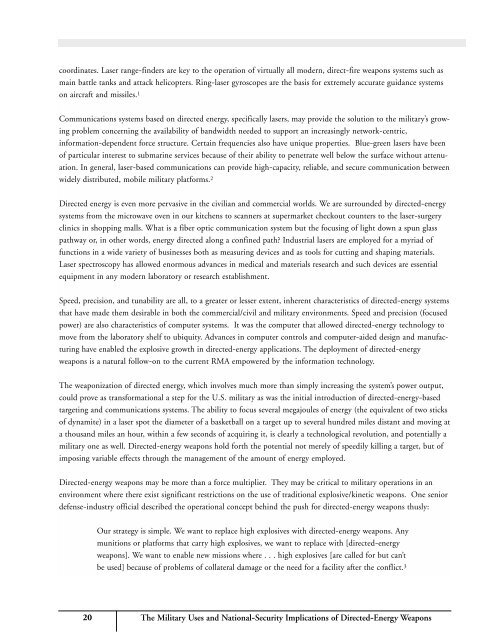directed-energy-weapons
directed-energy-weapons
directed-energy-weapons
You also want an ePaper? Increase the reach of your titles
YUMPU automatically turns print PDFs into web optimized ePapers that Google loves.
coordinates. Laser range-finders are key to the operation of virtually all modern, direct-fire <strong>weapons</strong> systems such asmain battle tanks and attack helicopters. Ring-laser gyroscopes are the basis for extremely accurate guidance systemson aircraft and missiles. 1Communications systems based on <strong>directed</strong> <strong>energy</strong>, specifically lasers, may provide the solution to the military’s growingproblem concerning the availability of bandwidth needed to support an increasingly network-centric,information-dependent force structure. Certain frequencies also have unique properties. Blue-green lasers have beenof particular interest to submarine services because of their ability to penetrate well below the surface without attenuation.In general, laser-based communications can provide high-capacity, reliable, and secure communication betweenwidely distributed, mobile military platforms. 2Directed <strong>energy</strong> is even more pervasive in the civilian and commercial worlds. We are surrounded by <strong>directed</strong>-<strong>energy</strong>systems from the microwave oven in our kitchens to scanners at supermarket checkout counters to the laser-surgeryclinics in shopping malls. What is a fiber optic communication system but the focusing of light down a spun glasspathway or, in other words, <strong>energy</strong> <strong>directed</strong> along a confined path? Industrial lasers are employed for a myriad offunctions in a wide variety of businesses both as measuring devices and as tools for cutting and shaping materials.Laser spectroscopy has allowed enormous advances in medical and materials research and such devices are essentialequipment in any modern laboratory or research establishment.Speed, precision, and tunability are all, to a greater or lesser extent, inherent characteristics of <strong>directed</strong>-<strong>energy</strong> systemsthat have made them desirable in both the commercial/civil and military environments. Speed and precision (focusedpower) are also characteristics of computer systems. It was the computer that allowed <strong>directed</strong>-<strong>energy</strong> technology tomove from the laboratory shelf to ubiquity. Advances in computer controls and computer-aided design and manufacturinghave enabled the explosive growth in <strong>directed</strong>-<strong>energy</strong> applications. The deployment of <strong>directed</strong>-<strong>energy</strong><strong>weapons</strong> is a natural follow-on to the current RMA empowered by the information technology.The weaponization of <strong>directed</strong> <strong>energy</strong>, which involves much more than simply increasing the system’s power output,could prove as transformational a step for the U.S. military as was the initial introduction of <strong>directed</strong>-<strong>energy</strong>-basedtargeting and communications systems. The ability to focus several megajoules of <strong>energy</strong> (the equivalent of two sticksof dynamite) in a laser spot the diameter of a basketball on a target up to several hundred miles distant and moving ata thousand miles an hour, within a few seconds of acquiring it, is clearly a technological revolution, and potentially amilitary one as well. Directed-<strong>energy</strong> <strong>weapons</strong> hold forth the potential not merely of speedily killing a target, but ofimposing variable effects through the management of the amount of <strong>energy</strong> employed.Directed-<strong>energy</strong> <strong>weapons</strong> may be more than a force multiplier. They may be critical to military operations in anenvironment where there exist significant restrictions on the use of traditional explosive/kinetic <strong>weapons</strong>. One seniordefense-industry official described the operational concept behind the push for <strong>directed</strong>-<strong>energy</strong> <strong>weapons</strong> thusly:Our strategy is simple. We want to replace high explosives with <strong>directed</strong>-<strong>energy</strong> <strong>weapons</strong>. Anymunitions or platforms that carry high explosives, we want to replace with [<strong>directed</strong>-<strong>energy</strong><strong>weapons</strong>]. We want to enable new missions where . . . high explosives [are called for but can’tbe used] because of problems of collateral damage or the need for a facility after the conflict. 320 The Military Uses and National-Security Implications of Directed-Energy Weapons


